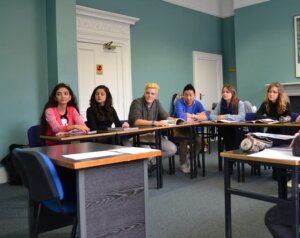How to develop a practical and immersive learning environment:
The effectiveness of English language instruction often depends on the teaching styles employed by the language school and the educator. The approach favoured can significantly impact the learners’ engagement and proficiency. Choosing from the very large range of teaching st yles and approaches, we here at Horner School of English believe that the integration of real-life communication skills and task based language activities are by far the most important elements to foster a practical and immersive learning environment in the language classroom.
yles and approaches, we here at Horner School of English believe that the integration of real-life communication skills and task based language activities are by far the most important elements to foster a practical and immersive learning environment in the language classroom.
Understanding Teaching Styles:
English language schools typically adopt one or a combination of the below teaching styles to cater to diverse learning needs. These teaching styles can include:
- The Direct Method: Focuses on oral communication and spontaneous use of language. It emphasizes vocabulary and speaking in full sentences without translating to the students’ native language.
- The Grammar-Translation Method: Centers on grammar rules and the translation of sentences between the target language and the students’ native language. This method is traditional but often criticized for its lack of emphasis on the spoken language.
- The Audio-Lingual Method: Involves repetitive drills and the mimicry of language patterns. This method aims to instill correct language habits through listening and speaking exercises.
- The Communicative Language Teaching (CLT) Method: Prioritizes real-life communication skills. This method encourages interaction and practical use of language in everyday scenarios.
- Task-Based Language Learning (TBL): Focuses on the completion of meaningful tasks, which simulates real-life use of language. This approach integrates language learning with practical activities that reflect authentic language use.
Which of the above styles are the most beneficial ?
Among these teaching styles, the integration of realistic English tasks and activities—particularly emphasized in CLT and TBL—prove to be highly beneficial. Here’s why:
1. Enhanced Engagement and Motivation: Realistic tasks captivate students by connecting language learning with their personal interests and real-world needs. Activities such as role-playing in job interviews, writing emails, or navigating travel scenarios make learning relevant and exciting, fostering a natural motivation to learn.
2. Practical Application: Language is a tool for communication. By engaging in tasks that mimic real-life situations, students develop practical language skills that they can immediately apply outside the classroom. This practical application bridges the gap between theoretical knowledge and real-world usage.
3. Improved Retention and Recall: Contextual learning aids memory. When students learn vocabulary and grammar through context-rich tasks, they are more likely to remember and recall the language accurately. For instance, learning the language of negotiation through a simulated business meeting helps in better retention compared to rote memorization.
4. Development of Critical Thinking and Problem-Solving Skills: Realistic tasks often require students to think critically and solve problems, using the target language as the medium. This not only enhances their linguistic abilities but also cultivates cognitive skills essential for real-life scenarios.
5. Cultural Competence: Engaging in realistic activities exposes students to cultural nuances and social norms of English-speaking communities. This cultural immersion is vital for learners to use language appropriately and effectively in diverse settings.
Implementing Realistic Tasks in the Classroom
To effectively implement realistic tasks, educators should consider the following strategies:
- – Needs Analysis: Understand the specific needs, interests, and goals of the students to design relevant tasks.
- – Authentic Materials: Use materials such as news articles, podcasts, and videos that reflect real-world language use.
- – Collaborative Learning: Encourage group activities and discussions to simulate real-life interactions and collaborative problem-solving.
- – Feedback and Reflection: Provide constructive feedback and encourage students to reflect on their performance to foster continuous improvement.






